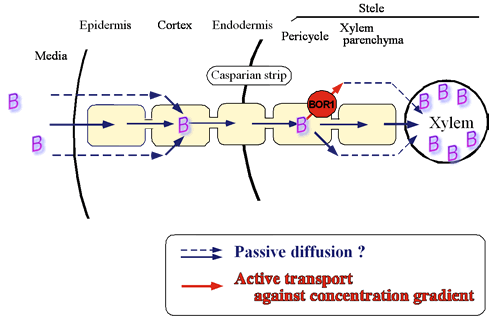植物の養分吸収に必須な遺伝子の同定と解析
植物の養分吸収に必須なトランスポーターを明らかにする。
植物は地球上の至る所に生育しています。火山の噴火などで植生が失われても植物がまず侵入します。これは植物が無機養分だけで生育することができるためです。土壌にある無機養分はトランスポーターを介して植物に吸収されます。
私たちはシロイヌナズナやイネを材料に、植物の無機養分のトランスポーターを同定し、その発現場所や活性についての研究を進めています。最近ではホウ素のトランスポーターを生物界で初めて同定することに成功しました(Takano et al., 2002, Nature)。このトランスポーターの性質をイネ、コムギ、ブドウなどの作物でも調べています(Nakagawa et al 2007 Plant Cell, Sumana et al 2013 Plant Cell Physiol.)。
また、モリブデンのトランスポーターを真核生物で初めて同定しました(Tomatsu et al, 2007 PNAS)。

A model of B transport pathway in Arabidopis root. B exists mainly as boric acid in the medium. Boric acid comes into roots by synplasmic or apoplasmic pathways but the latter pathway is constrained by the casparian strip at endodermis. Boric acid is taken into symplasm at epidermis, cortex, or endodermis by passive membrane transport and then transported towards stele via the symplasmic pathway. At pericycle, B is exported into steler apoplasm by passive transport of boric acid and active transport of boric acid or borate anion mediated by BOR1. The concentrated B is subsequently transported to shoot through xylem to satisfy plant’s B demand.